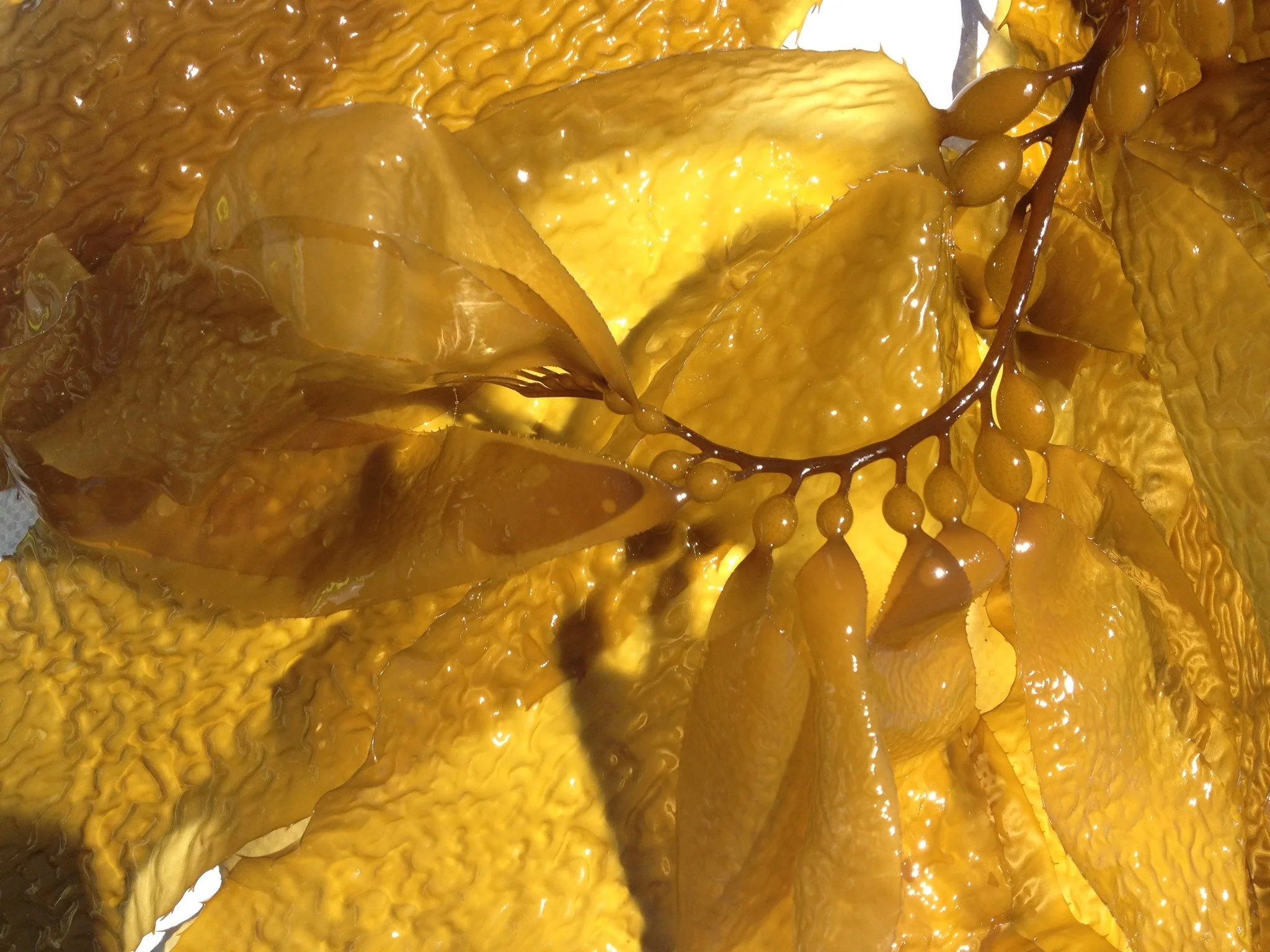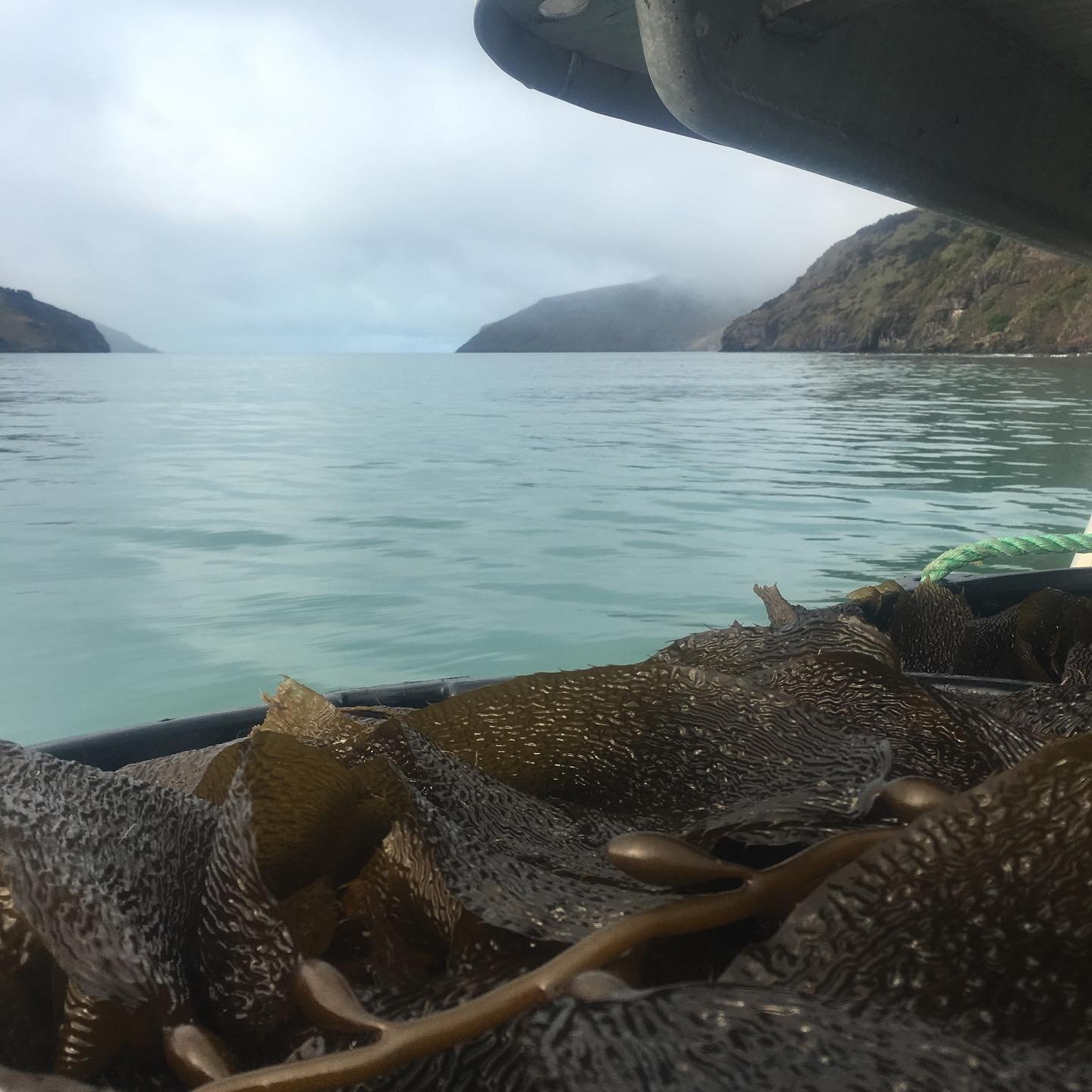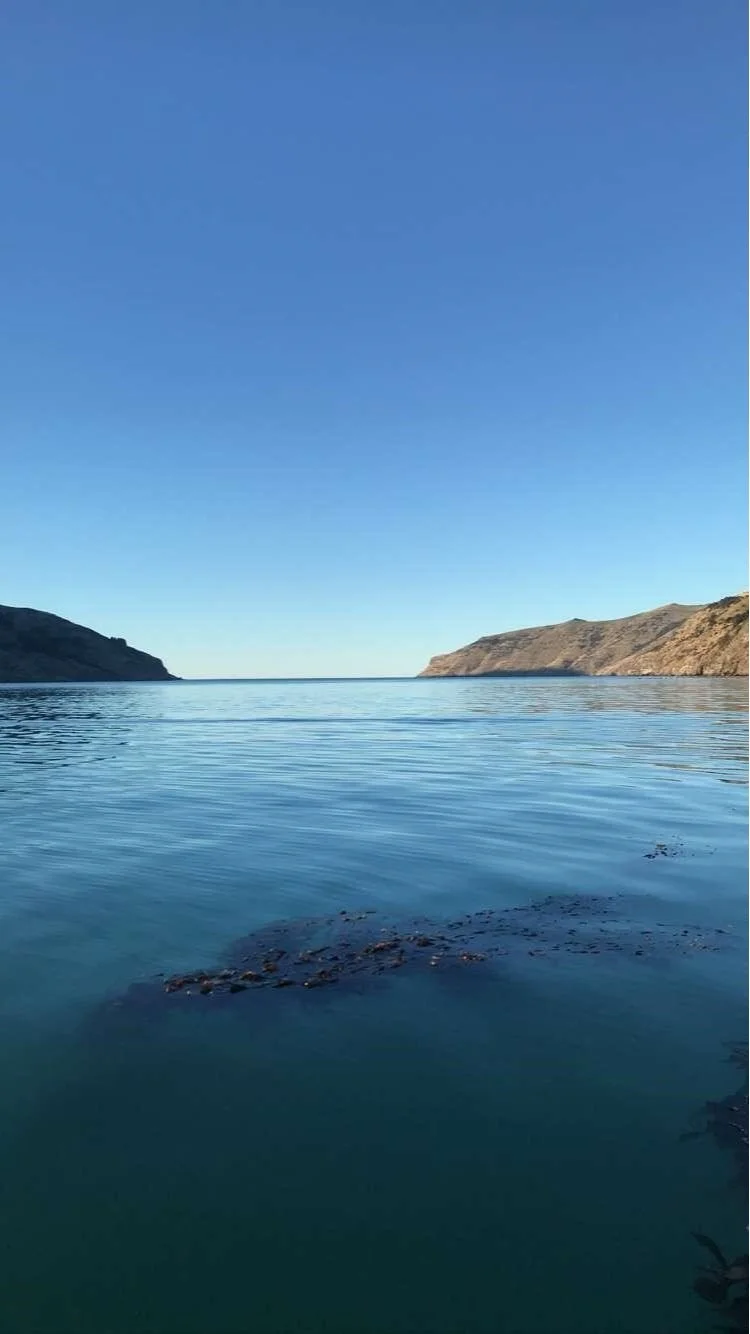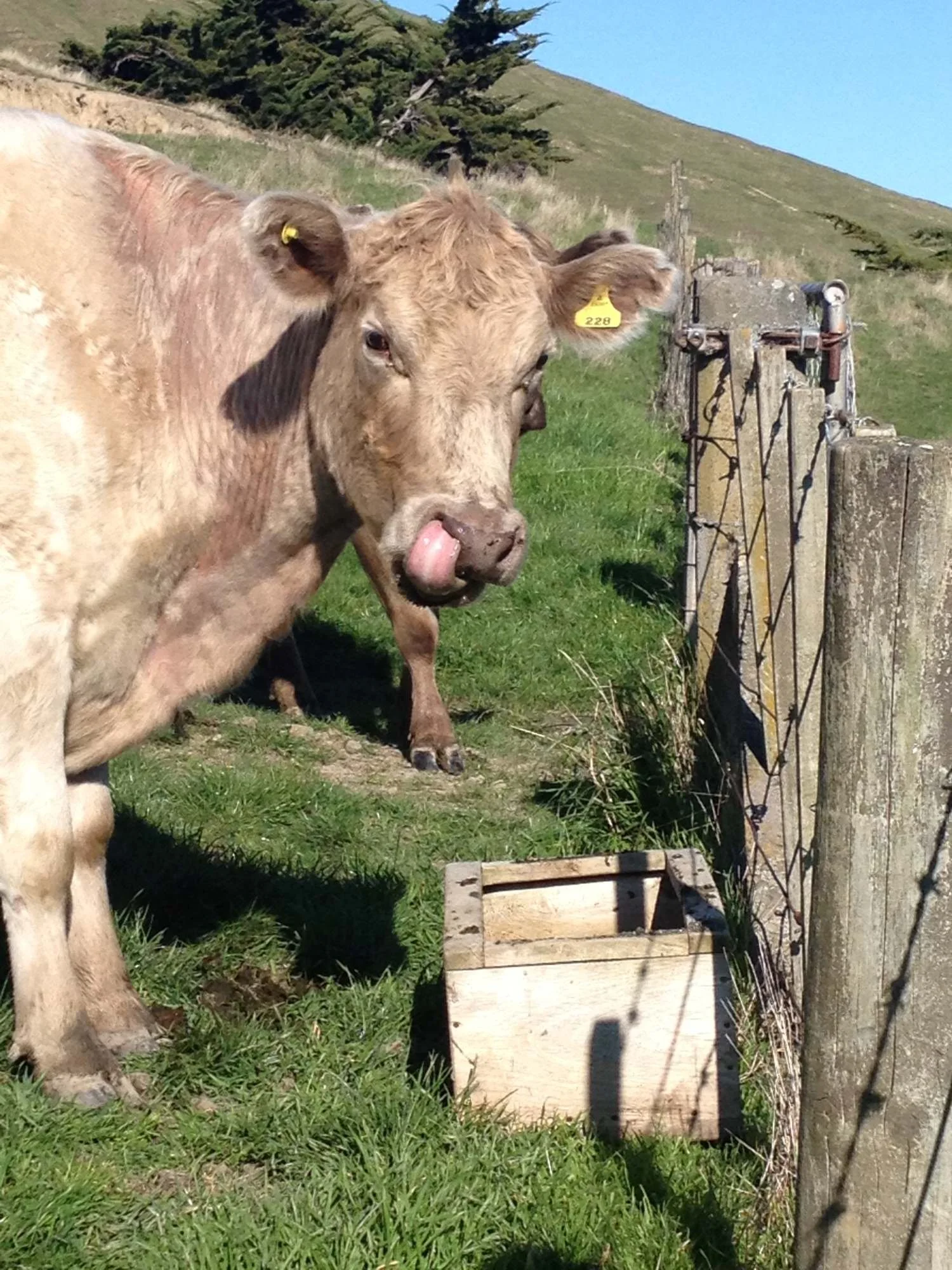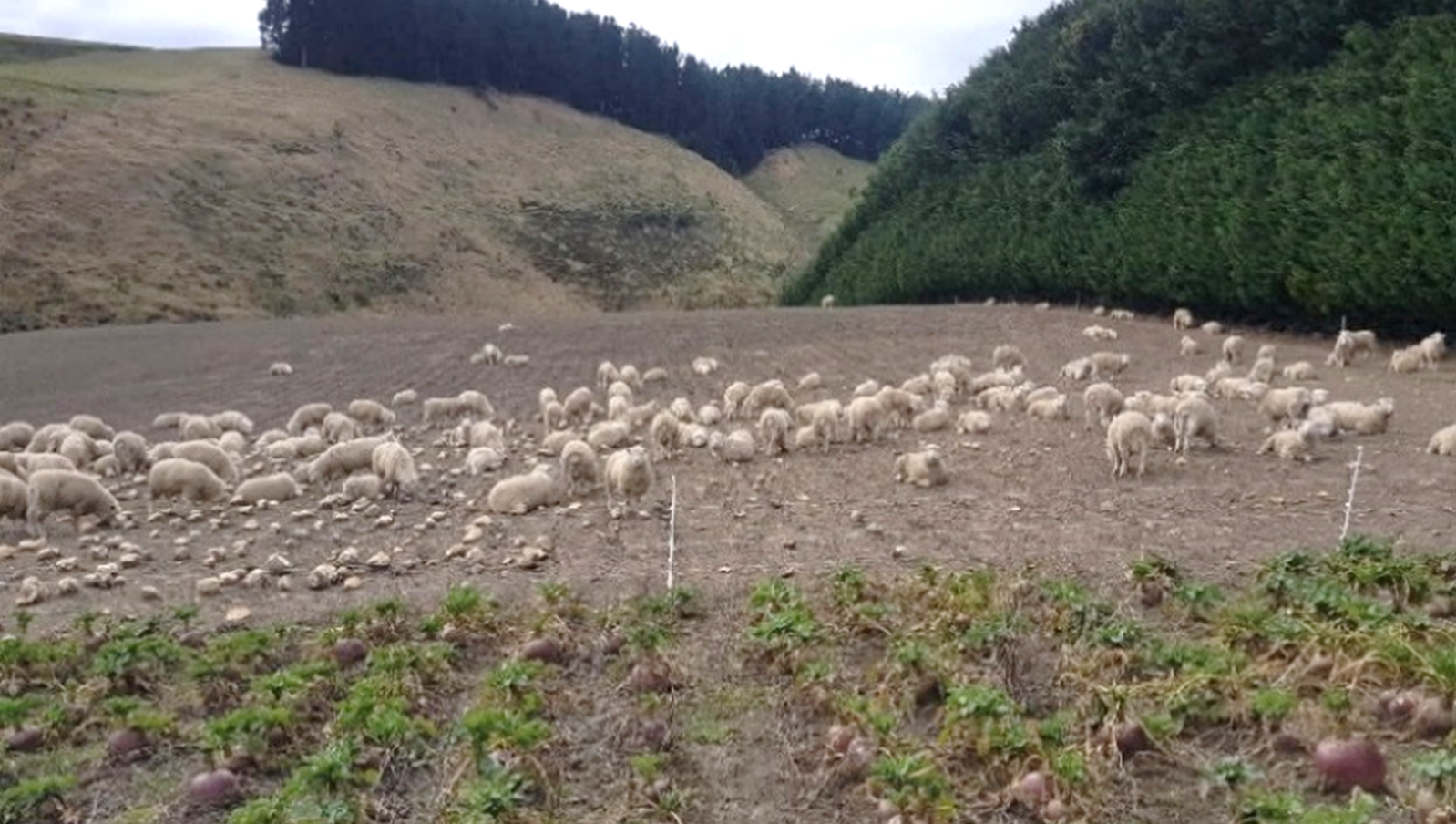Giant Kelp
Macrocystis pyrifera, (Giant kelp or Bladder kelp) is found in temperate regions of the Pacific Ocean, such as Chile, Australia, California, and New Zealand.
It is the fastest-growing organism on the planet (Schiel & Foster, 2015), growing up to 50cm per day, and reaching adult sizes of up to 60m in length.
To put that in perspective, if your lawn grew this quickly, you would have to mow it 7 times a day.
In its dried form, it is the world’s most concentrated natural source of Iodine.
Iodine is an element essential for human and animal health. Giant Kelp is also very high in alginates, a group of compounds used as thickeners and gels, found in toothpaste, ice cream, and pharmaceuticals. Due to its unique characteristics and commercial applications, it has been extensively studied and its biology is well understood. Recent developments in the New Zealand seaweed industry are finding uses beyond traditional alginate products, and towards value-added food & beverage products, nutraceuticals, pharmaceuticals, marine farming, pet foods, and biological stimulants for horticultural, arable & pastoral farming.
Giant Kelp Biology
“fastest growing and most prolific of all plant species found on earth.”
Schiel & Foster, 2015
In addition to a fast growth rate, it produces millions of spores that are capable of colonizing rocky substrates in a range of conditions, growing quickly, and becoming reproductive in less than a year.
Whole plants live for 2-6 years, during this time they naturally die back in summer and re-grow in the autumn, with individual fronds living for 4-9 months. Dieback is caused by a seasonal reduction in nutrients – warmer summer water holds fewer nutrients than colder winter water. In addition, entire plants are uprooted by the large swells caused by storms. Storms and seasonal dieback are two of the major causes of reductions in biomass. The reproductive, spore-producing blades (called sporophylls) occur at the base of the plant. The high growth rate, and short life cycle, in addition to having the sporophylls near the base, make Giant Kelp the most suitable of all kelps for harvesting (Schiel & Foster, 2015). It is like mowing the lawn of the ocean.
Lifecycle of Macrocystis pyrifera (Schiel & Foster, 2015)
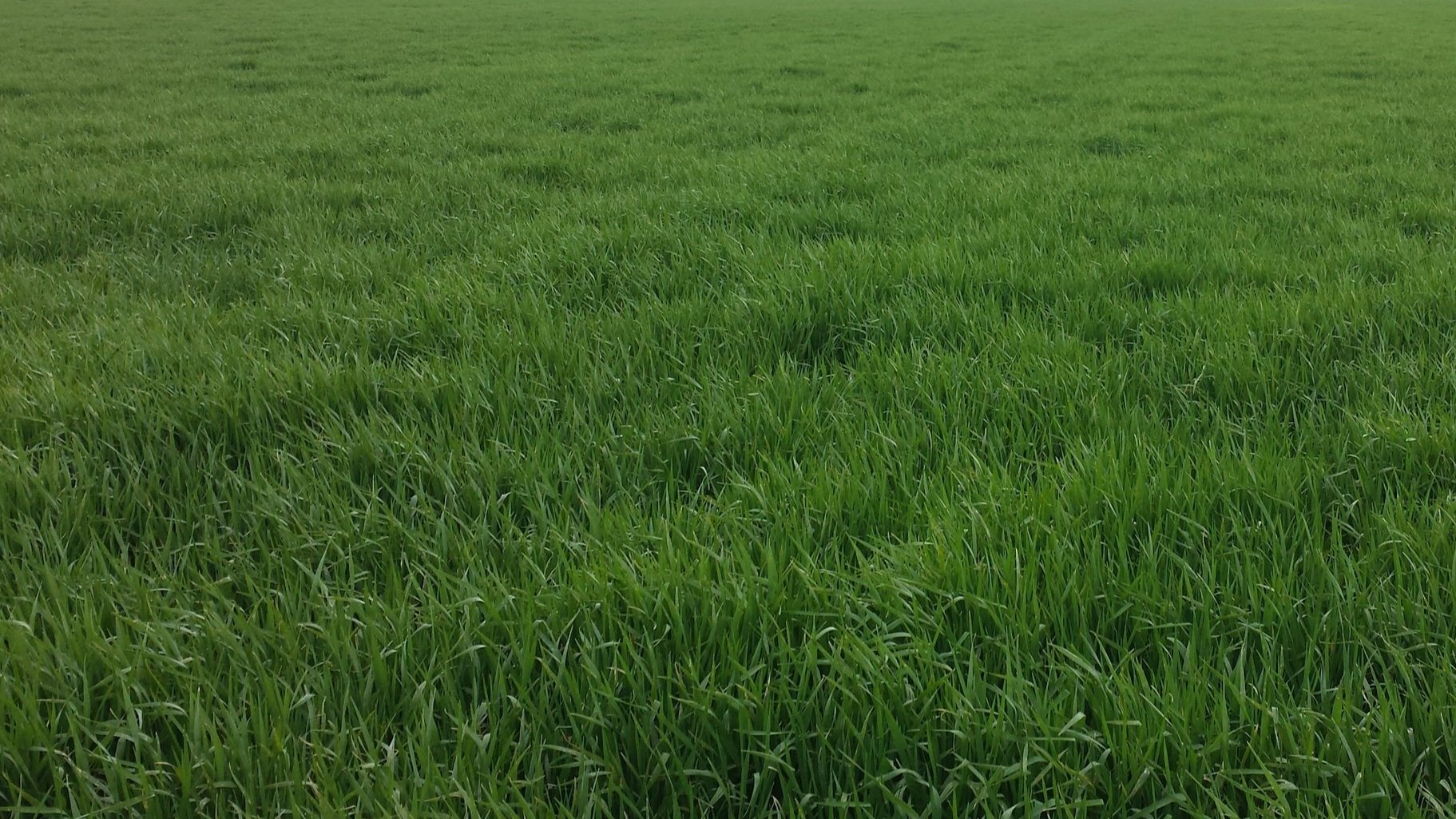
Chemical Farming vs Biological Farming
Industrialised agriculture has been ‘worshipped at the altar of productivity’ for many decades now, with a myopic view on how best to feed society. Large applications of artificial soluble fertilizer have a negative effect on beneficial bacteria and fungi in the soil. Intense pesticide, fungicide, and antibiotic regimes result in a higher yield in initial harvests but usually mask, create, and intensify any underlying fertility problems in the soil. Continued stress on soil, plants, and animals has led to increased health issues through chemical residues and lower nutrient density in food as a result of soil degradation.
Instead of fighting against biology, we should be working with it. It is a well-known phenomenon in ecology that diversity increases the biomass potential and provides resilience to environmental stress (Cardinale, et al., 2011) (Doak, et al., 1998). We should be creating an environment in our soils that can harbor productivity perpetually. Applying kelp to soils improves its health, increases the production per hectare, and improves resilience. The picture of barley on the right illustrates that Giant Kelp helps support the microbe relationships in the soil between the plant roots and mycorrhizal fungi. Plant exudates are secretions of sugars, enzymes, and carbon, and are a sign of a healthy plant-microbe relationship.
The Barley plant on the right shows a thick covering of soil on the roots. The plant on the left that received no kelp has bare roots, while the plant on the right that received kelp has its roots extensively covered in exudate. This result was after an application of 10kg/ha of dried kelp. The Giant Kelp helped the soil biology and the plant.
Leaf tests at the late tiller stage showed an average increase of 7.16% in key plant nutrients when the Giant Kelp was applied. The Giant Kelp had a beneficial effect on 11 nutrients, a neutral effect on 4, and a negative effect on 1.
A high brix level in plants means that the sugar levels are high. If sugar levels are high, the plant can give away more sugar to mycorrhizal fungi in exchange for minerals, allowing both fungi and plants to flourish.
According to one of New Zealand’s top consultants in biological farming, Rob Flynn, the number of biological farmers has grown from 1% ten years ago to 10% of farmers today. This is the equivalent of a 26% average compound growth rate over ten years. Rob predicts that in another ten years, 30% of New Zealand farmers will be biological.
Giant Kelp is changing the face of farming
Giant kelp is helping transform modern agriculture as a part of the biological farming movement. Farmers are now discovering the importance of farming the biology in the soil, rather than constantly supplementing the plants with chemicals.
Agrichemicals such as urea are damaging to soil ecosystems and New Zealand’s waterways. The major decline in our rivers is due to a combination of factors, but most of the causes can be traced back to one problem – intensive chemical farming. Giant Kelp is part of a movement to shift people away from this unsustainable style of farming.
For example, Nigel Greenwood, a horticultural farmer in Leeston has reduced his urea input by over 90% by using Giant Kelp and other biological farming products. Giant Kelp is high in plant growth hormones and natural stimulants. Nigel now uses 10x less than the ‘recommended’ quantity of urea, while consistently getting yields in the upper quartile. Without Giant Kelp, farmers such as Nigel will be forced to use more urea.

Giant Kelp harvesting mitigates climate change
Giant Kelp mitigates Climate Change in at least two ways
Methane Reduction
The first is that Kelp and seaweeds can reduce the amount of methane produced by ruminating animals (Foodtank, 2017).
Methane traps 30 times heat more so reducing methane emissions is a highly effective way of mitigating climate change.
Storing Carbon
The second is by accelerating the movement towards biological farming. The biological approach to farming builds more humus, thereby storing more carbon in the soil (Ghabbour, 2017). Chemical farming practices degrade the soil and damage the microbes involved in the carbon cycle, releasing carbon into the atmosphere rather than sequestering carbon.
Giant Kelp is high in sugars and carbon, and when we harvest Giant Kelp and apply it to land with Biological farming methods, we store more carbon in the soil – removing it from the atmosphere and locking it in the land. In the areas that were sustainably harvested, the growth of Giant Kelp proliferates, further removing carbon from the ocean & atmosphere.
We are removing carbon from the atmosphere directly through harvesting and indirectly through feeding soil microbes that store more carbon than they consume.
Giant Kelp is increasingly used as an essential ingredient in biological and organic farming regimes. Giant kelp is a catalyst in the soil/carbon-building process.
“The formation of humus is an anabolic process, that is, a building-up process. Rather than sugar being the end point, sugar is the start point. Soil microbes use sugars to create complex, stable forms of carbon, including humus.”
The ocean has a lot of iodine compared to the land. This means food from the ocean is the most iodine-rich. Giant kelp has the highest amount of iodine of any organism on the planet.
Based on chemical composition in our average analysis, a level teaspoon (1g) of dried Giant kelp has approximately 2678mg (or 2.678mg) of iodine. An 85g serving of cod (also considered a high-iodine food) has 99mg of iodine.
Iodine Superfood
The recommended daily intake (RDI) of iodine for adults is 150mg (NIH, 2018).
To meet your RDI of Iodine you can either have 128g of cod (Atlantic Cod), or 0.05g (1/18th of a tsp) of Giant Kelp.
Giant kelp is 2500 x higher in Iodine than Cod.
“Iodine deficiency is the world’s most prevalent, yet easily preventable, cause of brain damage.
”
Iodine deficiency is associated with a multitude of disorders, most notably goitre (enlargement of the thyroid gland) and cretinism which causes stunted physical and mental growth. Iodine deficiency has also been associated with lethargy, weight gain, suppressed immune system, depression, and anxiety (Dr Edward Group DC, 2015). The most severe disease associated with iodine deficiency is cretinism and this has been successfully eradicated from affluent countries, primarily due to widespread iodization of salt. It is, however, still prevalent in some poorer regions of the globe and is still estimated to affect 2 million children globally each year (Zimmerman & Anderson, 2012). One study of iodine supplementation showed a 50% reduction in the number of infant deaths and an average increase in IQ of 16 points.
Iodine deficiency is still prevalent in New Zealand.
“91% of New Zealanders are deficient in iodine.”
This is because NZ soils are extremely low in Iodine, which causes the food we produce to also be low in Iodine. With growing demand for natural salts, the role of Giant Kelp in preventing Iodine deficiency will become increasingly important. Harvesting of Giant kelp for human consumption could help alleviate iodine deficiency diseases which are still an issue today. By supplementing grazing animals with Giant Kelp and applying Giant Kelp directly to pasture or crops we are increasing the amount of iodine in the overall population’s diet.
Human Health Benefits
Giant kelp is the ideal plant to naturally supplement and prevent iodine deficiency in the diet. Iodine is needed in the thyroid gland to produce hormones that affect the function of virtually all our organs.
Animal Health
Low levels of iodine in the soil affect the growth and health of plants, and the health of the animals that eat those plants. Iodine deficiency affects animals as well as humans. Administering kelp to stock can greatly improve the vitality and virility of animals. Feeding kelp to stock has a range of benefits including; enhanced immune function, longer cycles of reproductive activity, better conception, healthier offspring, fatter animals, faster growth rates, improved feed conversion efficiency, greater resilience to stress, slicker more lustrous coats, lower somatic cell counts, reduced lice problems, less fly pressure, fewer internal parasites, less pink eye, less foot/hoof problems and a better functioning endocrine system.
“Iodine is the most important mineral for the human or cattle.
The most important hormone in the body is the
thyroid hormone and the thyroid needs iodine”
- Dr Paul Dettloff - Acres USA, June 2011
“If an animal is deficient in iodine, no matter what vitamins or minerals are given, they will not be assimilated properly until the iodine requirements have been met.”
Cropping Trials
Control side of paddock - lots of Swedes left over
NZ Kelp has run and had products involved in numerous trials for a range of crops showing positive effects.
This includes increased yield, faster growth, improved germination, greater resistance to disease & pests, greater resilience to drought, improved quality, higher brix levels, higher nutrient density, higher palatability, better colour, and more uniformity of size.
Kelp side of paddock - all of the Swedes eaten
Results from one trial show that adding Giant Kelp at 1g/m (23 kg/ha) was highly effective, with a 27% increase in yield of first-grade carrots compared to the control. From an economic point of view, $483/ha spent on Giant Kelp resulted in $7,897/hectare more revenue. This is a 16x return on investment in kelp for the farmer.
Several other experiments (shown below) on cropping products show the benefits Giant Kelp has for agriculture. Results shown are comparing crops sown with Giant Kelp against control crops (no Giant Kelp applied). All these results are for bare untreated seeds.
Several days after grazing, the sheep had eaten all the Swedes on the Giant Kelp side, and very little from the control
Sustainable Harvesting
Fresh kelp floating in Akaroa Harbour
“The growth and reproductive characteristics of Macrocystis make it the most suitable of all kelps for harvesting”
— Schiel & Foster, 2015
“Overall there were no negative flow on effects resulting from harvesting the kelp forests.”
Harvesting of Giant kelp in California has been sustainable since the early 1900s. Harvesting spiked up to 400,000 tons during WW1 for the creation of potash for gunpowder. Scientists even found that removing the canopy increases light at the bottom which enhances the growth and recruitment of new plants (Rosenthal, Clarke, & Dayton, 1974) (Kimura & Foster, 1984).
In the three-and-a-half-year study that evaluated the sustainability of commercial harvesting of Giant Kelp in NZ, they found:
Roger Beattie & NZ Kelp published a report
GIANT KELP - GIANT OPPORTUNITY
for the benefit of present & future generations. Click here to view a copy
